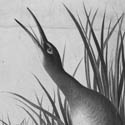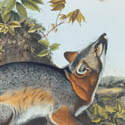The Sinkler and Cope Collections, 1976 and 1992
The most magnificent of all color-plate books are the fine bird books of the mid-19th century, and by being thrifty and hoping to have them donated, we managed to miss out on most of them. In the last generation, however, we have been lucky to acquire two stunning collections of bird books that have made up for many of our omissions.
The Sinkler Collection, 1976
In 1976 Louise Elkins Sinkler gave the Library Company her superb collection of ornithological color-plate books. Her collection turned out to fit perfectly with the Library Company’s unpredictable gaps. For example, her Catesby was the second edition, the one we ordered but did not buy. With the Historical Society of Pennsylvania’s first edition on deposit, the Library Company now has all three editions on its shelves.
The Cope Collection, 1992
In 1992 the Library Company was appointed trustee by court order of the Francis R. Cope, Jr. collection of ornithological color-plate books after its original custodian, the Susquehanna County (Pennsylvania) Historical Society, became unable to take proper care of it. Among the seventy titles are the complete works of John Gould, often styled the British Audubon, and a fine copy of Audubon’s elephant folio Viviparous Quadrupeds of North America (New York, 1845-1848).
The elephant folio Birds of America is still lacking, but the Cope Collection gives us reason to hope for a second chance.
 Cephas Grier Childs, after John J. Audubon. Rallus Crepitans, Marsh Hens. Philadelphia, 1832. Gift of C.G. Childs, 1832.
Cephas Grier Childs, after John J. Audubon. Rallus Crepitans, Marsh Hens. Philadelphia, 1832. Gift of C.G. Childs, 1832.
This is one of four known copies of the only lithograph Audubon ever made from his ornithological drawings. All his other birds were engraved, but this experiment, made during a brief visit to Philadelphia while the publication of the birds was underway in Edinburgh, showed the potential of lithography to vary texture and display depth of tone. Audubon must have seen it, because he chose lithography for the 1840-1844 octavo edition of the Birds of America, and more significantly, he turned again to a Philadelphia lithographer, J.T. Bowen, for his masterpiece the elephant folio Quadrupeds.
 John James Audubon and John Bachman. Viviparous Quadrupeds of North America. New York : J.J. Audubon, 1845-1848. The Francis R. Cope Jr. Collection, in trust, 1992.
John James Audubon and John Bachman. Viviparous Quadrupeds of North America. New York : J.J. Audubon, 1845-1848. The Francis R. Cope Jr. Collection, in trust, 1992.
John James Audubon is best known as a bird artist, but after he had completed his elephant folio Birds of America in 1838, he turned his attention to mammals. He used the same huge format and the techniques that had made him famous, drawing all specimens full-size from direct observation in lushly rendered natural habitats and in life-like postures and activities. However, instead of having his 150 plates engraved on copper in England, he had them drawn on stone and printed in Philadelphia by master lithographer J.T. Bowen. Their richness of tone if anything exceeds that of the Birds. This was the crowning achievement of his career.
 Richard Bowdler Sharpe. Monograph of the Paradiseidae, or Birds of Paradise. London: H. Southeran, 1891-1898. Gift of Louise Elkins Sinkler, 1976.
Richard Bowdler Sharpe. Monograph of the Paradiseidae, or Birds of Paradise. London: H. Southeran, 1891-1898. Gift of Louise Elkins Sinkler, 1976.
John Gould was the most prolific publisher of color-plate bird books in the 19th century, and his artistic and scientific successor R. Bowdler Sharpe continued and exceeded the work of his master in this magnificent book on birds of paradise. From Gould he learned how to portray the iridescent plumage of these birds by using transparent oil and varnish colors over gold leaf laid on the paper. This was the last of the great color-plate books, and perhaps the most sumptuous of them all.